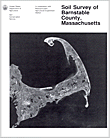The following is a map unit description from the "Soil Survey of Barnstable County, Massachusetts (Fletcher, 1993)"

MaA-Maybid silt loam, 0 to 3 percent slopes.
This very deep, nearly level, very poorly drained soil is in depressions, at the base of swales, and in low areas bordering ponds, streams, and swamps. It formed in areas of glacial lake deposits. It makes up about 0.1 percent (1 72 acres) of the survey area. It is mapped mainly in the Plymouth-Eastchop-Carver-Boxford general soil map unit. Areas are irregular in shape and range from 5 to 60 acres in size.
Typically, this soil has an organic surface layer. This layer is about 1 inch of loose, undecomposed leaves and twigs and 2 inches of dark reddish brown muck. The mineral surface layer is very dark grayish brown, friable silt loam about 5 inches thick. The subsoil is gray, mottled, friable silty clay loam about 13 inches thick. The substratum to a depth of 65 inches or more is mottled, firm silty clay loam. The upper 10 inches is gray, the next 6 inches is light olive brown, the next 1 1 inches is gray, and the lower part is greenish gray.
Included with this soil in mapping are small areas of Berryland, Scitico, Swansea, and Walpole soils. Also included are areas where the content of clay is less than 35 percent. Included soils make up about 30 percent of this unit.
Permeability is moderately slow in the surface layer of the Maybid soil and slow or very slow in the subsoil and substratum. Available water capacity is high. A seasonal high water table is at or near the surface during most of the year.
Most areas are used as woodland. Some areas support shrubby vegetation.
This soil is very poorly suited to cultivated crops. Wetness is a major management concern. It severely limits crop growth and interferes with the use of machinery. Surface drains, diversions, tile drains, or a combination of these can help to remove excess water.
This soil is very poorly suited to hay and pasture.
The seasonal high water table is a limitation. Installing a drainage system and planting water-tolerant species improve the suitability for hay and pasture. Restricted grazing when the soil is wet and proper stocking rates help to maintain plant density and desirable species.
This soil is poorly suited to woodland because of the wetness and a high seedling mortality rate. The optimal growth and survival of seedlings are not expected. Because of low soil strength, the use of equipment should be limited to periods when the soil is dry or frozen. Onsite investigation may identify areas where trees can be planted if special management is applied. The most common trees are red maple, tupelo, and holly.
The seasonal high water table limits the use of this soil as a site for dwellings and septic tank absorption fields. The slow or very slow permeability in the substratum also is a limitation on sites for septic tank absorption fields. Alternative sites should be selected.
This soil is well suited to wetland wildlife habitat. The common native plant communities provide adequate food and cover for nesting areas.